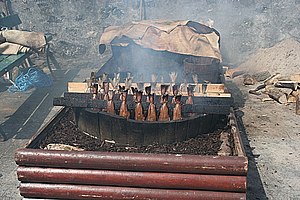Smoked fish
The traditional method involves the fish being suspended in smokehouses over slowly smouldering wood shavings.
Salmon, mackerel and herring are universally available both hot-smoked and cold-smoked, while most other fish is traditionally preserved by only one of the smoking methods.
A commonly used name for cold-smoked salmon is lox, which is actually a different cured fish product of Jewish origin.
Jewish delis often sell, in addition to lox, hot-smoked whitefish, mackerel, trout, and sablefish (also sometimes referred to as black cod in its fresh state).
Traditionally, in the US, cold-smoked fish, other than salmon, is considered "raw" and thus unsafe to consume without cooking.
In the Netherlands, commonly available varieties include both hot- and cold-smoked mackerel, herring and Baltic sprats.
In Israeli cuisine, smoked trout is traditionally eaten as part of meze, especially at breakfast.
With the increased use of the idiomatic expression "red herring", references to the smoked fish product in this manner declined.
Arbroath Smokies (haddock) and Traditional Grimsby smoked fish (haddock and cod) have both received Protected Geographical Indication status from the European Commission,[11][12] which restricts use of the name to fish that is processed using specific methods within a defined geographical area.


